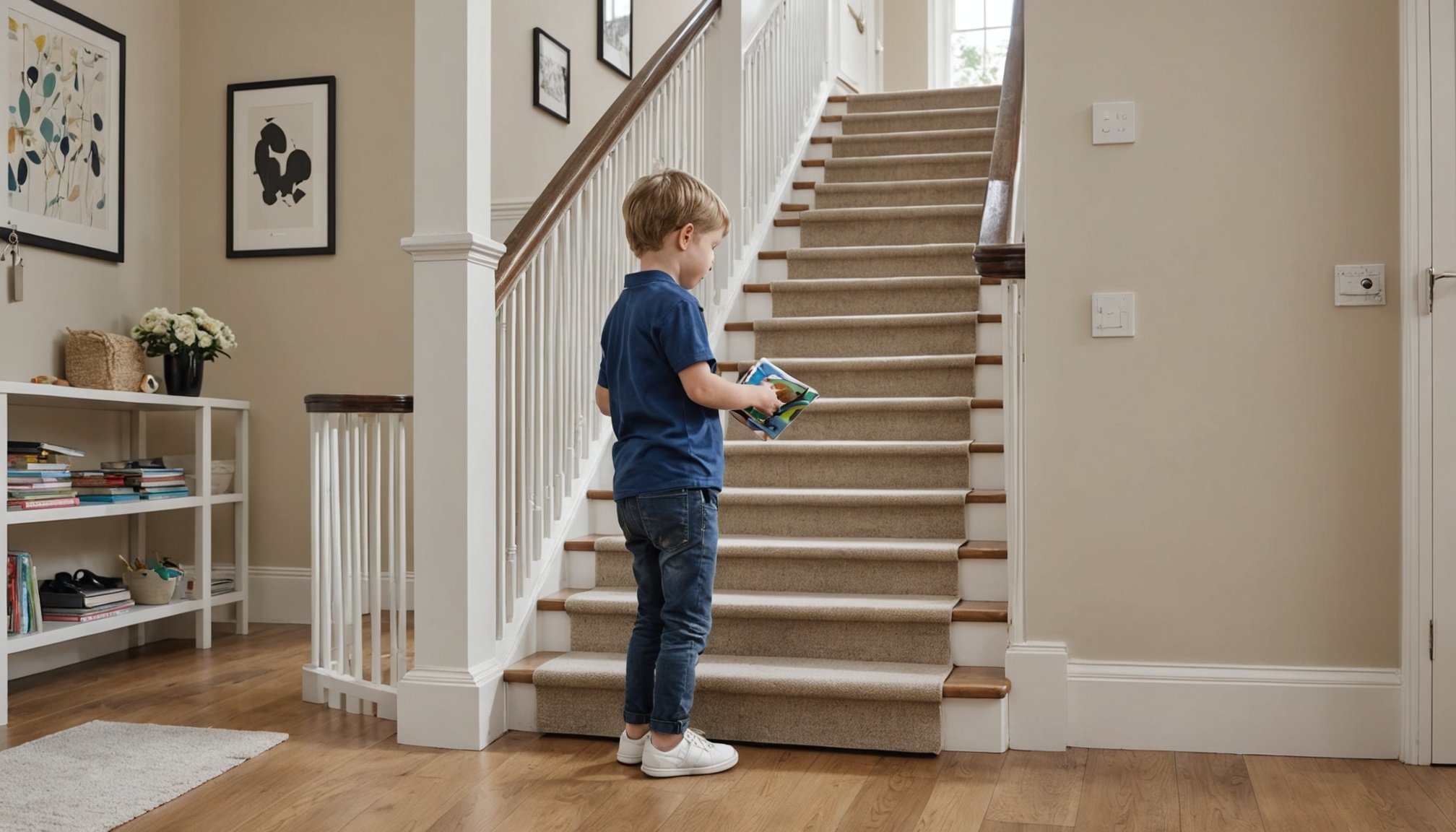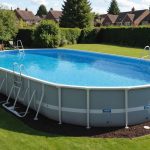Importance of Stylish and Child-Safe Stair Designs
Striking a balance between aesthetic appeal and child safety in stair designs is vital for homeowners with young children. An eye-catching staircase can serve as a central visual feature in a home, yet traditional designs often lack the necessary safety features for little ones. This dual focus on style and safety addresses parental concerns without compromising on visual flair.
Traditional staircases, with their hard edges and exposed heights, pose several potential hazards. For instance, open risers and wide gaps in railings can allow small children to slip through, causing severe accidents. Furthermore, slick surfaces and steep steps increase the risk of dangerous falls. By implementing child safety stair designs, these dangers can be significantly reduced.
Avez-vous vu cela : Exploring Cutting-Edge Soundproofing Techniques for Urban Apartment Living in the UK
Did you know that according to the American Academy of Pediatrics, stairs are a common source of injury for children? Their research highlights that over 90% of stair-related injuries in young children occur at home. This statistic underscores the importance of creating staircases that blend stylish staircases with enhanced safety features.
Modern design innovations, such as enclosed risers, adjustable gate systems, and slip-resistant materials, offer practical solutions for ensuring home safety for children. Such designs allow for a seamless integration of safety measures without aesthetic compromise, ensuring peace of mind for parents and a visually pleasing environment for all.
Sujet a lire : Essential Water Conservation Tips for Your UK Garden During a Hosepipe Ban
Overview of Child-Safe Stair Features
Designing child-proof stairs requires careful consideration of various safety features in stair design. By incorporating specific elements, you can greatly enhance the safety and security of your home for children.
Non-Slip Materials
The use of non-slip materials for stair surfaces is crucial in preventing accidents. These materials reduce the risk of slipping, particularly if children are running or wearing socks. Implementing surfaces such as anti-slip treads or strips ensures added safety by providing a firm grip underfoot.
Secure Railings
Secure railings act as an essential barrier to safeguard children on the stairs. They provide essential support, preventing falls and giving children something to hold onto. Opt for railings with vertical bars that are spaced closely together to discourage children from sticking their heads or limbs through.
Soft Edges and Rounded Corners
Soft edges and rounded corners minimize the risk of injuries if a child accidentally bumps into a staircase. These features act to cushion any potential impact, reducing injury severity in case of contact. Using components made from softer materials, or cushioning sharp corners, is a practical solution for enhancing safety features in stair design.
Incorporating these elements into your staircase options helps in creating a secure environment for children while providing peace of mind for parents.
Stylish Stair Design Ideas
Crafting an inspiring staircase transforms any space into a visual masterpiece, pushing the limits of form and function.
Curved Staircases
The intricate, sweeping lines of curved staircases embody elegance and fluidity. They invite you to explore the graceful combinations of wood, metal, or glass. Ideal for those seeking aesthetic stair designs, curved staircases become focal points. They soften sharp architectural lines and make grand entrances captivating. Moreover, curved stairs adapt seamlessly into varying spatial layouts, offering a blend of tradition and modernism.
Open Concept Stairs
Open concept stairs redefine modern staircase ideas by breaking visual barriers. These designs create an illusion of spaciousness, enhancing light flow and connectivity throughout the home. With fewer materials blocking sightlines, they allow for a seamless integration with surrounding decor. Whether suspended or featuring minimalist rails, open concept stairs fit small apartments or larger residences.
Multi-Material Designs
Experimenting with multi-material designs introduces both visual variety and stability. Combining wood, metal, glass, or even stone, these unique stair styles stand out for their bold contrasts and robust structure. Multi-material designs contribute to safety without sacrificing style. This amalgamation ensures that your staircase not only becomes a central design piece, but also enhances its durability and utility. With aesthetic stair designs like these, safety and beauty coexist harmoniously.
Recommended Materials for Stair Construction
Choosing the right materials for constructing stairs is essential for safety, durability, and ease of maintenance. Staircases serve as a pivotal element in any home, particularly for families with children.
Wood vs. Composite Materials
When considering safe stair materials, wood and composite materials are common options. Wood offers a classic look, but requires frequent maintenance to prevent wear and tear. In contrast, composite materials are a durable staircase option needing less upkeep. They often resist moisture damage better than wood, making them a sound investment long-term. Nonetheless, both materials can be made safe for children with the addition of non-slip treatments and regular inspections.
Metal Elements
For those favouring a modern aesthetic, metal elements can enhance both the functionality and safety of staircases. Metal railings and balusters provide robust support and are often easier to clean. They pair effectively with other materials and often incorporate child-friendly features such as closed risers and non-slip surfaces.
Safe Paint and Finishes
Paints and finishes play a crucial role in maintaining staircase safety and ensuring they are safe for children. Environmentally-friendly, low-VOC paints are recommended for their health benefits, reducing the risk of harmful exposure. Additionally, anti-slip finishes can further ensure a children-friendly environment, minimising the risk of accidents. Prioritizing safety in all elements is important for overall peace of mind.
DIY Stair Safety Enhancements
Creating a secure environment at home is paramount, especially when children are involved. Enhancing child-proof stairs can be straightforward and manageable with some simple DIY stair safety solutions.
Adding Safety Gates
Safety gates are a primary solution for preventing accidents on stairs. They serve as effective barriers, especially for young children who might not have developed the necessary coordination. When installing a safety gate, ensure it is sturdy and fits securely against the wall or railing. Opt for models specifically designed for staircases, which often have a walk-through feature to maintain convenience for adults. It’s crucial that the material and locking mechanism of the gate can withstand pressure and constant use.
Installing Non-Slip Treads
Non-slip treads are ideal for added traction on stair surfaces. They’re particularly useful on wooden or stone stairs, which can become slippery. To install, clean the stair surface thoroughly, then apply the self-adhesive treads, pressing firmly to avoid bubbles. Make certain the treads are wide enough to cover the entire width, ensuring a consistent and safe surface.
Customizing Handrails
Customizing handrails not only adds a decorative element but enhances safety as well. Consider designs that are comfortable to grip and ideally extend the entire length of the stairs. Materials like wood, metal, or rubber provide both durability and aesthetic appeal. Integrating these child-proof features can significantly reduce risks associated with stairways, making your home a safer place for everyone.
Safety Regulations and Standards in the UK
Understanding UK stair safety regulations is crucial in ensuring the safety of stairways, especially in environments frequented by children. Building codes for stairs in the UK are structured to minimise the risk of accidents.
Overview of Building Regulations
UK building regulations articulate specific requirements for stair design. This includes the dimensions of risers and treads, as well as the need for handrails. These regulations are crafted to ensure that stairs are uniformly safe and accessible. They stipulate, for instance, that the maximum riser height should not exceed 220mm to avoid steepiness, while tread depths must be at least 220mm for secure footing. Such measures are pivotal in maintaining safe stair transitions.
Safety Certifications for Stair Products
Products related to stair construction and safety must align with certain standards. Safety certifications, like the British Standard Kitemark, serve as indicators of compliance. These certifications signify that the products have undergone rigorous testing and are deemed safe under recognized guidelines. Thus, consumers can be assured of purchasing articles that meet stringent safety thresholds.
Resources for Compliance
For families keen on ensuring adherence to child safety standards, resources abound. The UK government website provides comprehensive guides on building regulations. Access to such resources empowers individuals to implement enhanced safety measures in their homes or facilities, drawing clarity on compliance requirements.
User Reviews and Recommendations
Family recommendations, particularly related to stair designs, are invaluable for ensuring safety and style. Parents often seek testimonials from others who have navigated similar challenges to guide their decisions.
Testimonials from Parents
Parents who prioritize safety find certain stair designs especially beneficial. Many underscore the importance of continuous handrails on both sides, noting their efficacy in preventing accidents. Child-safe products, such as gates and anti-slip treads, gain frequent praise in user reviews, emphasizing their practicality in family homes. One parent recounted, “Our staircase went from a danger zone to a child-safe haven with these simple additions.”
Best Rated Stair Designs
When it comes to the best-rated designs, a few stand out for their synthesis of style and safety. Designs incorporating wide treads and low risers tend to receive acclaim, as they make navigation easier for young children. Floating staircases with glass panels also emerge as favourites for their modern aesthetic and the visibility they provide to monitor children.
Popular Suppliers and Retailers
For those looking to purchase, several retailers come highly recommended. User reviews frequently laud suppliers that focus on child-safe designs without sacrificing style. Many parents recommend suppliers with diverse catalogues that include modifiable features to suit various needs. Retailers such as SafeSteps and FamilyFirst are often mentioned for their excellent customer service and quality products.











